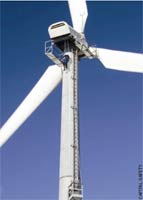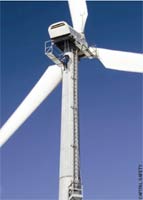
Cultivating Safety at Wind Farms
- By Donald Galman
- Jan 01, 2009
 Wind towers reap the power of wind to generate electricity. How ironic, then, that wind towers can take the wind out of those who must repair, maintain, or inspect equipment there. According to one published account, three wind tower technicians were installing bolts in a turbine in a wind tower in Minnesota when their work ignited a fire. The tower quickly became engulfed in flames. One worker fell more than 200 feet and died; the other two escaped with injuries.
Wind towers reap the power of wind to generate electricity. How ironic, then, that wind towers can take the wind out of those who must repair, maintain, or inspect equipment there. According to one published account, three wind tower technicians were installing bolts in a turbine in a wind tower in Minnesota when their work ignited a fire. The tower quickly became engulfed in flames. One worker fell more than 200 feet and died; the other two escaped with injuries.
The event provoked discussion about the industry-wide need to educate workers on safe practices for confined space entry in wind towers. The trainees identified include wind energy technicians, municipal workers, county inspectors, and others. The problem is, wind towers contain several potentially hazardous compartments. OSHA has identified the turbine area as a permit-required confined space. Other permit-required spaces depend on wind tower design and may include the basement electrical room or telecom vault and trenches or excavation pits dug in the construction phase. Other areas, such as the hub, or nose cone, and turbine blades, are classified as non-permit required confined space but may be re-classified as permit-required confined space if some substance or operation (e.g., arc welding) is performed there. The point is, all compartments must be evaluated for risk.
Oxygen depletion is always a concern when working in confined spaces. Toxic fumes can arise from heat or electrical sparks igniting solvent-based resins or other volatile organic compounds used to lubricate turbines, blades, and electrical apparatus. Workers who must crawl into the narrow channel of a blade to inspect lightning protection equipment and repair the blades or fiberglass skin can be subjected to off-gassing from battery acids or VOCs. The decomposition of a dead bird or rodent in a confined space may displace enough oxygen from the environment to cause an unsafe oxygen level.
The American Wind Energy Association, OSHA, and other regulatory agencies have posted notices on confined space hazards posed by wind towers and have pointed to the need for confined space training.
The smart technician will make it a habit to perform air samples prior to entering a confined space. In following best practices, the technician should carry a portable gas monitor in the toolkit and practice due diligence in its operation and maintenance.
Gas Monitoring
A portable multi-gas detector is the instrument of choice for wind tower technicians because it can warn of the multiple threats posed by confined space entry, detecting toxic gases in parts per million levels and flammable gases at the lower explosive limit (LEL). A standard four-gas detector will include sensors for monitoring oxygen, combustible gases, carbon monoxide, and hydrogen sulfide. These four gases deserve special mention in confined space work.
Hydrogen sulfide, also called sewer gas, is heavier than air and can accumulate in electrical vaults, basements, and other areas underneath the tower. The characteristic “rotten egg” odor can be detected by smell at lower levels and for short duration; at higher levels, the gas can cause dizziness leading to unconsciousness. Methane, the primary component of natural gases, is a combustible gas found often in confined spaces. Produced by leaks in pipelines, methane, along with propane and other flammable gases, must be monitored with a combustible gas sensor that gives an alert at the lower explosive limit. A standard four-gas portable monitor is equipped with a flammable gas sensor. Carbon monoxide, a byproduct of the incomplete combustion of hydrocarbon compounds, can be found where any gas-powered equipment is used. Oxygen levels must be determined prior to entry of a confined space. Oxygen can be consumed by oxidation from rusting equipment, bacteria growth, displacement by another gas, or rotting vegetation. Oxygen sensors are included in a standard four-gas monitor.
Thankfully, these gas threats can be averted by following due diligence in regard to OSHA and NIOSH confined space requirements and by gaining a working knowledge of a confined space portable gas detector.
Many portable gas detectors are designed for simple ease of use. Premium models may offer additional details, including large, backlit displays and oversized, heavy-duty buttons. These features help the user operate and view gas readings in foggy, dark, or wet conditions. Check to see whether the unit logs standard data, as well as event and calibration data that can be loaded onto a computer program in case the data must be retrieved. If any of your crew has a limited understanding of English, check whether the portable unit offers multilingual display or voice-assisted operation.
The unit should convey alarm annunciation in multi-sensory ways, audibly (through a distinctive loud sound), visually (through strobe), and tactilely (through vibration). In this way, workers will be alerted to emergency alarms, quickly and without fail.
Training in the use of a portable gas detector should include the following “commandments”:
• Always test the atmosphere before entering a confined space.
• Always test for oxygen levels.
• Perform a bump (functional) test and learn how to calibrate your instrument properly or obtain professional assistance on how to do so.
• Perform continuous testing for flammable and toxic gases upon entering the space (having completed pre-entry checks).
• Make certain all of your crew’s portable gas detectors are in good working order.
• Use fully serviceable equipment.
• Consider time- and money-saving premium features.
• Make sure the unit is rugged.
Be Safe, Not Sorry
The wind energy industry is the fastest-growing segment of renewable energy production. In the next few years, hundreds of technicians will enter the field. And as the nation’s wind towers age, repairs will inevitably increase, with more frequent confined space entries. The time for practicing due diligence in confined space work is now. With a little preparation, you can maximize the short- and long-term value of your company’s investment in portable gas detection instrumentation. You can track evidence of safety and compliance; protect people, equipment, and environment; and increase company profitability. Learning how to use a portable gas detector takes you one step forward on the way to a long, rewarding career in a dynamic industry.
This article originally appeared in the January 2009 issue of Occupational Health & Safety.